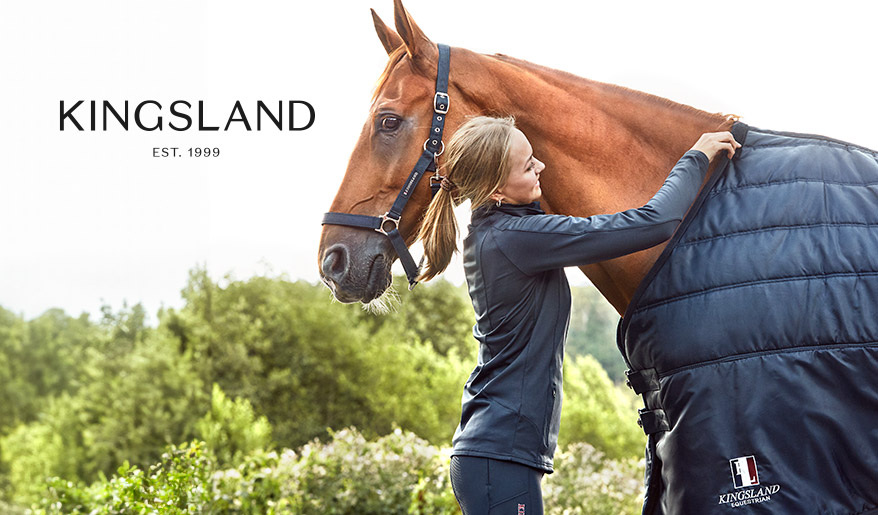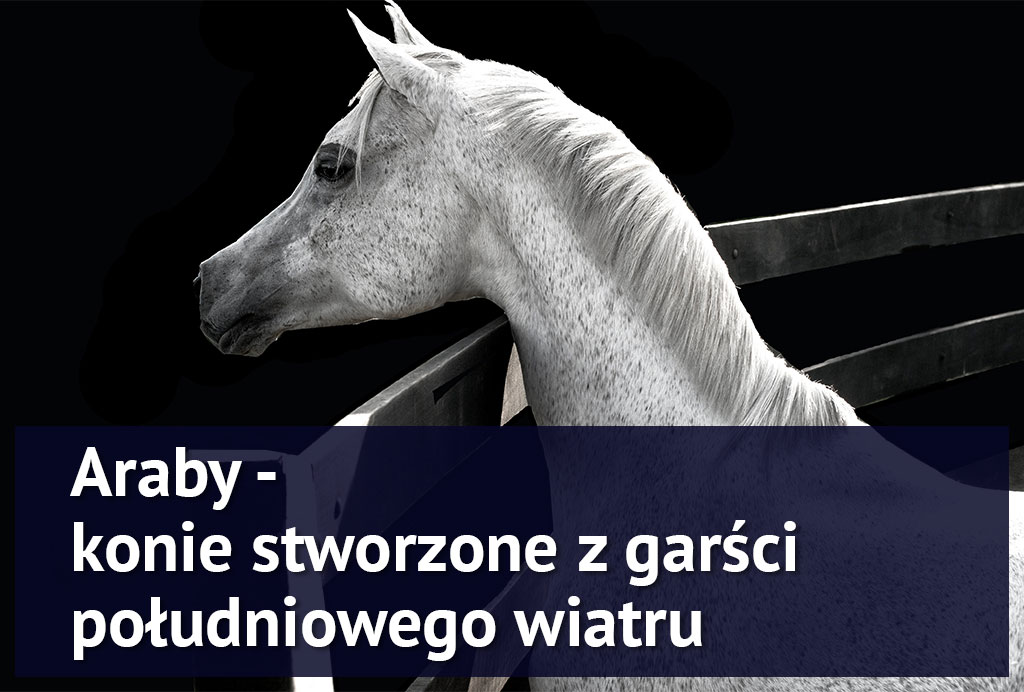
Koń - arab, czyli czysta krew arabska przez wielu uważana za piękno absolutne i “ojca” wszystkich ras. Pewna legenda mówi, że konia arabskiego Bóg stworzył z garści południowego wiatru, formując go w zwierzę stworzone do lotu, choć bez skrzydeł. Wiele w tej legendzie prawdy, ponieważ kto zobaczy galopującego konia arabskiego nie będzie mógł oprzeć się wrażeniu - że zwierzę nie dotyka ziemi, a płynnie, unosi się w powietrzu.
Koń czystej krwi arabskiej - historia rasy
Koń arabski z pewnością pochodzi z bliskiego wschodu. Pierwsze osobniki tej rasy zostały udomowione na półwyspie arabskim około 2500 lat temu. Jedna z legend o koniach arabskich głosi, że Mahomed poddał próbie swoje konie - przez cały dzień pozostawiając je bez jedzenia i wody, a wieczorem wzywając je do siebie i dając sygnał do bitwy. Na wezwanie odpowiedziało tylko 5 klaczy, które zamiast zaspokoić swoje pragnienie przy wodopoju, dołączyło do swego przewodnika, by wspólnie obronić się przed rzekomym najazdem wroga. To właśnie od tych pięciu klaczy mają pochodzić dzisiejsze konie czystej krwi arabskiej.
Istnieje wiele innych opowieści, jak powstał koń czystej krwi arabskiej. W każdej z pewnością zawarte jest ziarno prawdy. Bohaterkami tych legend są często klacze, które według pierwotnych hodowców rasy - Beduinów, charakteryzowały się większą wytrzymałością, odpornością i łagodnością niż ogiery. Cechy te były niezwykle ważne w trudnych, pustynnych warunkach.
Beduini bardzo szanowali swoje konie, traktując je jak członków swojej rodziny i dając schronienie w namiotach. Świadczyć o tym może chociażby stare arabskie przysłowie “niech głodują i odczuwają pragnienie moje dzieci, ale nigdy mój koń”.
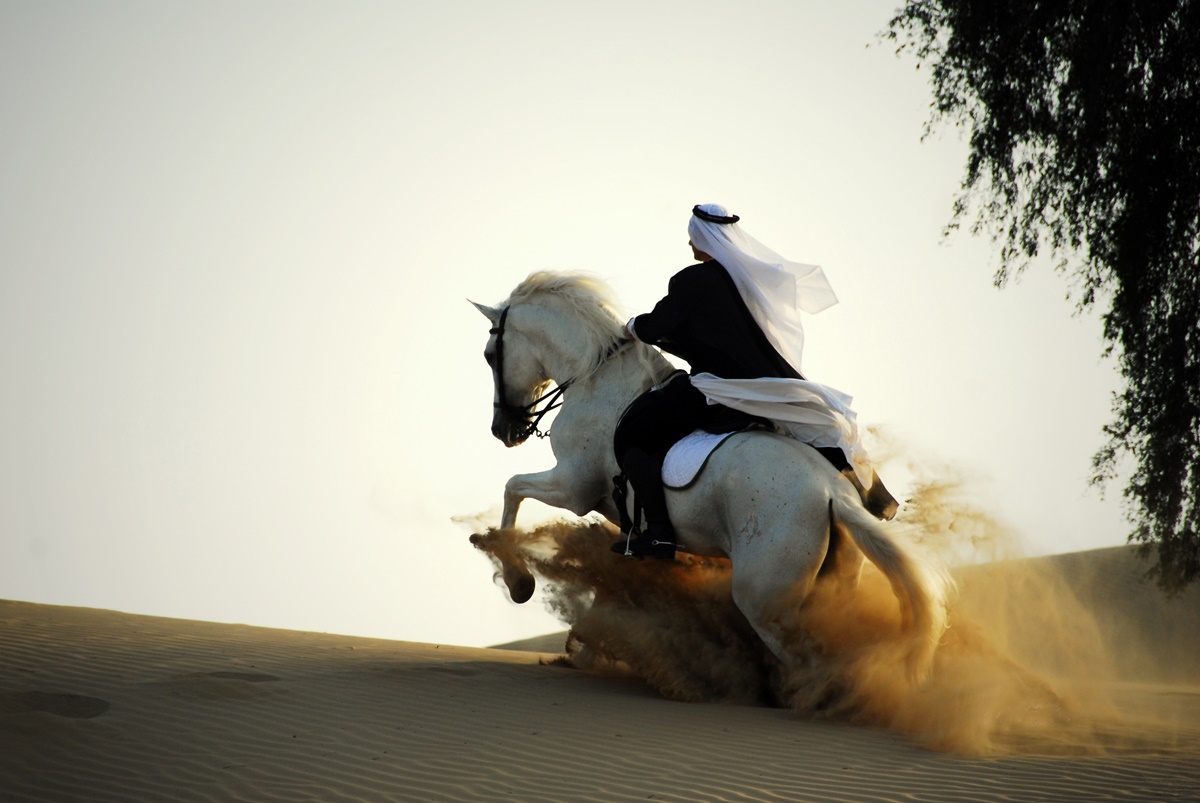
Swoje istnienie dzisiejsze konie arabskie zawdzięczają przede wszystkim trzem ojcom-założycielom - ogierom Kuhailan, Saklavi i Munighi. Poza nimi wyróżnia się też inne np. Hadban, Hamdan, O’Bajan.
Obecny obszar hodowli rasy obejmuje tereny od Afryki Północnej przez Półwysep Arabski aż do Iranu. Hodowla prowadzona jest także w krajach Europy (Polska, Anglia, Niemcy, Francja) i w Stanach Zjednoczonych.
Najważniejszą organizacją skupiającą konie oraz hodowców koni rasy arabskiej jest World Arab Horse Organization (WAHO), która zajmuje się problemami hodowlanymi tej rasy.
Koń arabski w Polsce - hodowla
Polska hodowla koni arabskich jest jedną z najbardziej znanych na świecie. W efekcie wielopokoleniowej, konsekwentnej pracy hodowców i tym samym starannej hodowli koni uzyskano jedne z najpiękniejszych koni. Co ciekawe, w polskiej hodowli stawiano głównie na prezencję koni, a nie tak bardzo na ich wytrzymałość fizyczną (inaczej niż np. we Francji, gdzie hodowane są wierzchowce predestynowane do sportowych rajdów konnych).
Ośrodki hodowli koni arabskich w Polsce to m.in:
Pozostałe, często zupełnie nowe hodowle znajdziecie tutaj. Wszystkie są zarejestrowane w Polskim Związku Hodowców Koni Arabskich, który przynależy do ogólnoświatowego WAHO (World Arabian Horse Organization). Warto wiedzieć iż, wiele utytułowanych koni pojawia się u hodowców prywatnych.
Araby w Janowie Podlaskim
Najbardziej znanym ośrodkiem hodowlanym w Polsce jest zdecydowanie Stadnina Koni Janów Podlaski w Wygodzie, istniejąca od 1817 roku. Coroczna sierpniowa aukcja przez lata przyciągała kupców z całego świata, stając się prawdziwym świętem koni arabskich. Była ona wydarzeniem na którym uczestnicy mogli na własne oczy zobaczyć wiele sławnych, utytułowanych koni.
W Internecie można do dzisiaj znaleźć wiele zdjęć koni arabskich prezentowanych w poprzednich latach. Nie tylko konie są prawdziwym pięknem tego miejsca, ale również sama architektura: klasycystyczne budynki stajenne oraz ogromne połacie łąk, lasów i parków. Co ciekawe, tereny Stadniny to 2500 ha, co stanowi ok. 18% powierzchni gminy Janów Podlaski.
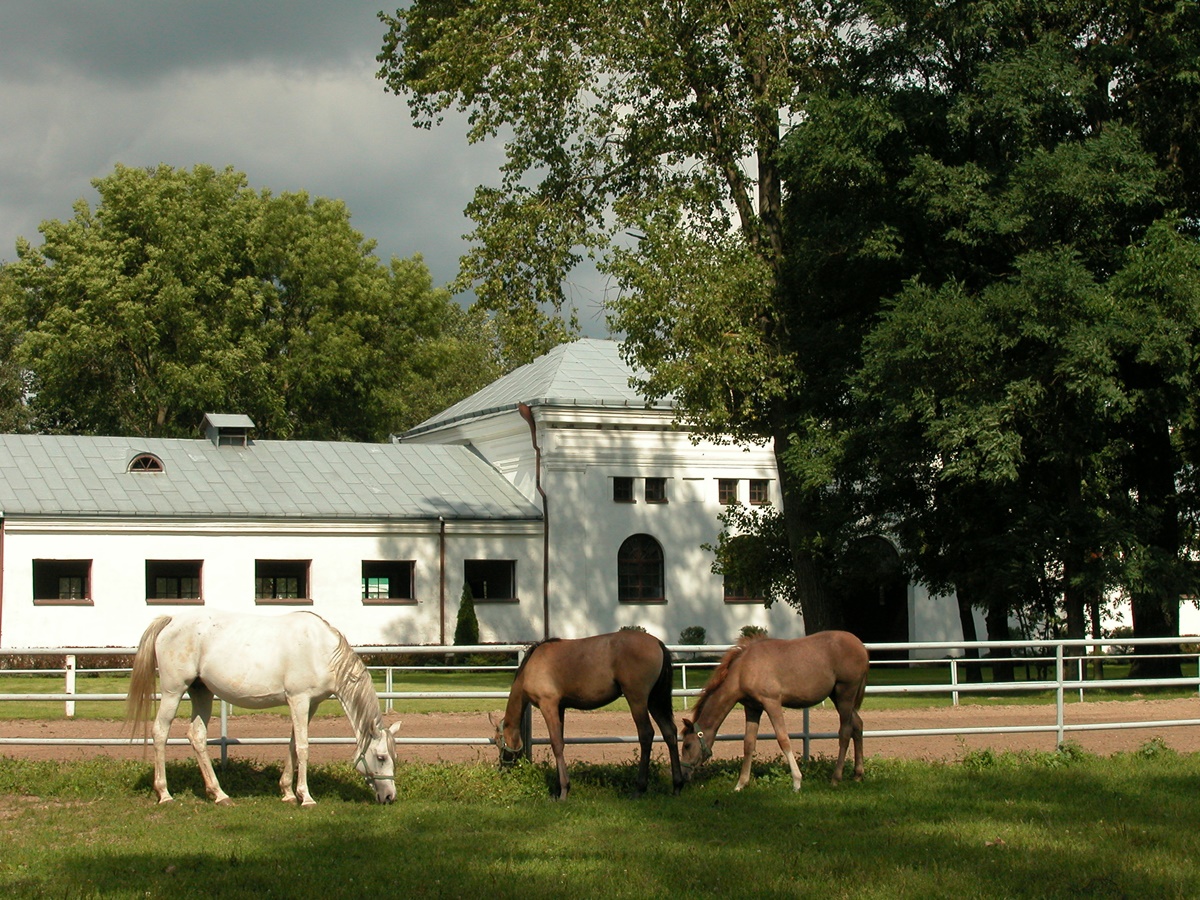
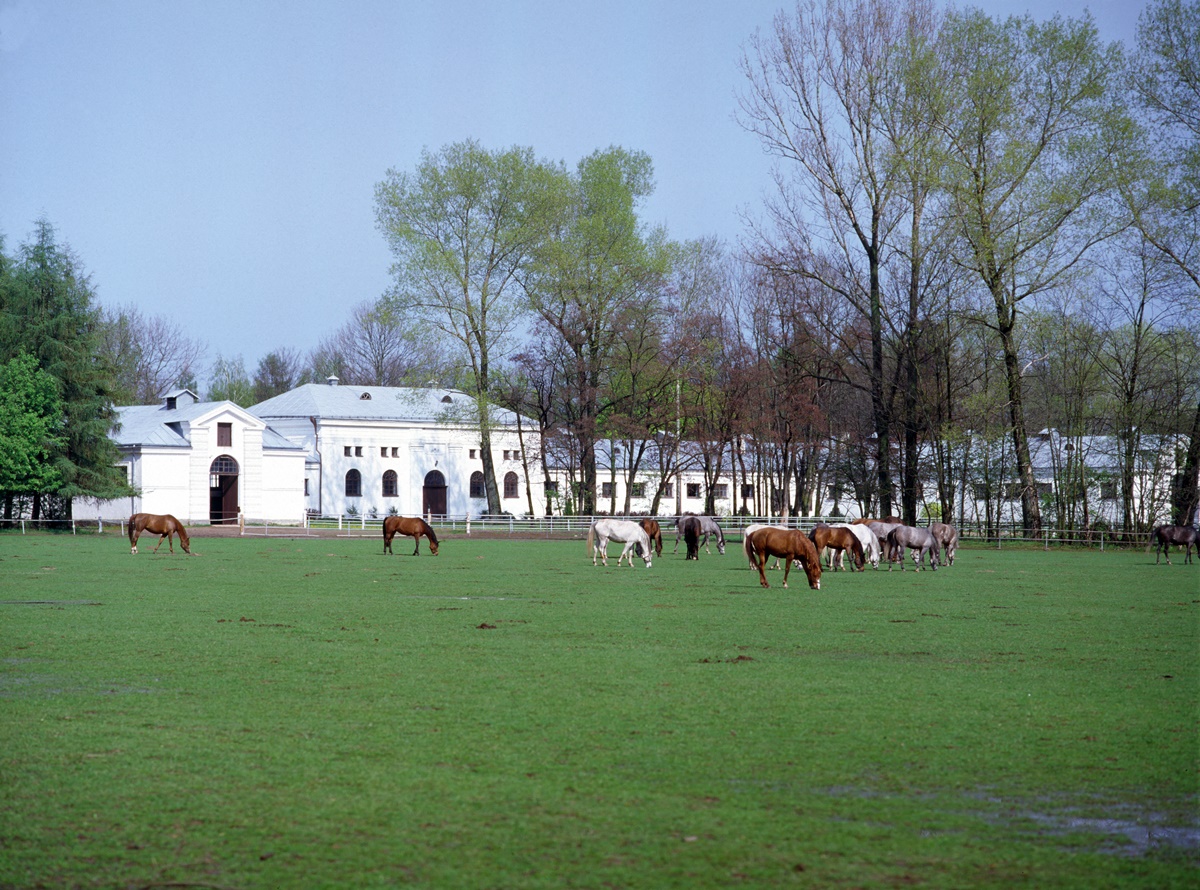
Historia powstania tego miejsca sięga czasów napoleońskich, kiedy to w wyniku wojen liczba koni na ziemiach polskich znacząco spadła. Dekretem cara Aleksandra I na wniosek Rady Administracyjnej Królestwa Polskiego utworzono państwowe stado koni, które dało początek obecnej hodowli tych niemalże egzotycznych zwierząt.
Do czasu powstania styczniowego nadzór nad polską stadniną pozostawał w polskich rękach. Po wybuchu I wojny światowej w 1914 r. kierownictwo przejęli carscy urzędnicy, a same konie wkrótce zostały ewakuowane w głąb Rosji. Niestety żaden z nich już nigdy nie powrócił.
Po odzyskaniu niepodległości przez Polskę stadnina odrodziła się, powołując nowego dyrektora - Stanisława Pohoskiego i jego zastępcę - Andrzeja Krzyształowicza. Nowe kierownictwo dzięki skutecznym działaniom, rozpoczęło sukcesywną odbudowę hodowli konia arabskiego, jak i samej stadniny.
W 1920 r. do SK Janów Podlaski przywieziono trzy klacze, które dały początek trzem najważniejszym liniom żeńskim: Mlecha, Sahara i Gazella.
Jeszcze tuż przed wojną Gustav Rau - niemiecki hipolog odwiedzający Stadninę, napisał, że nigdzie na świecie nie widział takich koni arabskich, jakie hodowane są w Janowie Podlaskim. Wraz z nadejściem II wojny światowej dotychczasowa hodowla znów stanęła pod znakiem zapytania. Jeszcze na parę dni przed wejściem sowietów do Polski we wrześniu 1939 r. próbowano ewakuować ok. 200 koni, transportując je w kierunku Wołynia. Niestety po wkroczeniu Armii Czerwonej zwierzęta przewieziono z powrotem do Stadniny w Janowie Podlaskim. Podczas transportu powrotnego wiele koni zaginęło, a sama Stadnina wkrótce została zrabowana i podpalona przez sowiecką armię.
Wkrótce na teren Stadniny wkroczyły też wojska niemieckie, a z nimi wspomniany już Gustav Rau - komisarz ds. hodowli i koni, który przejął dowodzenie w Janowie Podlaskim. Sprowadził on z powrotem sławy tej rasy - ogiery: Witraż, Wielki Szlem oraz inne konie arabskie czystej krwi.
Latem w 1944 roku stado liczące ok. 300 koni arabskich ewakuowano do niemieckiego Drezna. Miasto wkrótce zostało zbombardowane, a samo stado poniosło straty liczebne. Araby powróciły jednak do kraju 6 lat później, dzięki transporcie drogą morską - do Janowa Podlaskiego trafiło 80 koni (klaczy i źrebaków). Ogiery - rozproszone po świecie udało się sprowadzić dopiero w 1960 roku. Wtedy też nastąpił prawdziwy rozkwit stadniny, na której czele, już jako dyrektor stanął Andrzej Krzyształowicz, który doprowadził do skutku pierwszą aukcję koni arabskich dla kupców zagranicznych w 1969 roku.
W międzyczasie pojawiły się kolejne ważne linie żeńskie koni arabskich, którym początek dały takie klacze jak: Milordka, Ukrainka, Szweykowska, Wołoszka, Selma, Rodania, Adjuze czy Semrie, których potomstwo można spotkać do dziś.
Polskie konie arabskie wywodzą się z linii takich ogierów jak: Kuhailan Haifi, Ilderim, Bairactar, Saklawi I, Krzyżyk, Kuhailan Afas, Ibrahim, Abu Argub II, Kuhailan Zaid, Latif I, Koheilan Adjuze, Wafi czy Mirage.
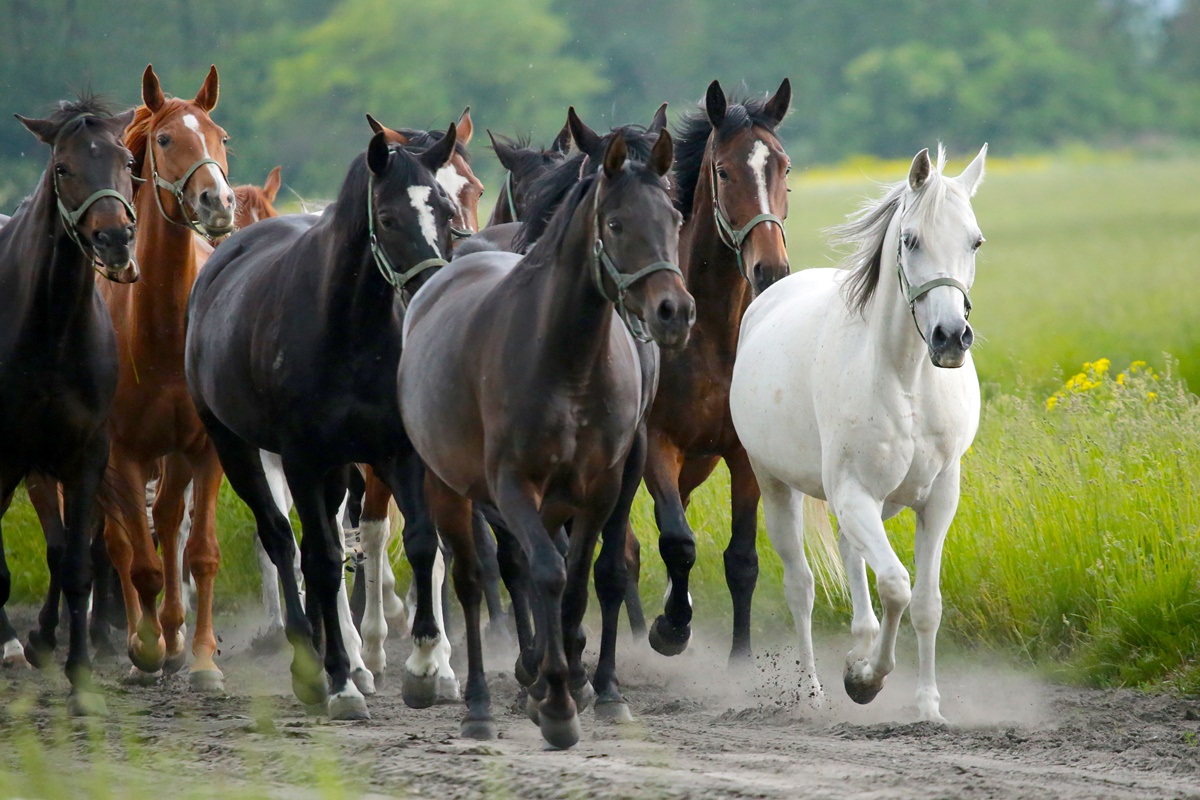
Od czasów pierwszej aukcji za granice Polski sprzedano ponad 1000 koni. Największymi sukcesami była na pewno sprzedaż ogiera El Paso za 1 mln dolarów w 1980 roku, klaczy Penicylina za 1,5 mln dolarów. Rekord osiągnięto na najważniejszej aukcji w ciągu roku - Pride of Poland, gdzie za cenę 1,4 mln euro sprzedano klacz Pepita w 2015 roku. Jest to jak dotąd najdroższy koń z polskiej hodowli.
SK Janów Podlaski to nie tylko aukcje, ale też i pokazy koni, które odbywają się praktycznie od wiosny do jesieni - zarówno koni arabskich, jak i angloarabskich. Rasa sprawdzana jest też na torze wyścigowym w gonitwach płaskich - najważniejsze z nich są Derby (podobnie jak w przypadku pełnej krwi angielskiej).
Koń arabski - budowa i charakterystyka
Konie arabskie mają budowę tak charakterystyczną, że nie sposób jest pomylić ją z jakąkolwiek inną rasą. Co więcej, jej wpływ widać w wielu innych rasach - w tym również polskich (chociażby u koni małopolskich).
Ogólnie opisując konia arabskiego, w porównaniu do innych ras ma on suchą, niewielką głowę o często szczupaczym profilu (wklęsłym), z bardzo ruchliwymi, sierpowatymi uszami, osadzoną na delikatnej, lekkiej szyi. Jest to koń o węższej głowie o dużych nozdrzach. Niesamowite wrażenie robią ich oczy - duże, bystre, pełne energii.
Uwagę przykuwa ich łabędzia szyja o widocznym umięśnieniu. U koni tej rasy wyróżnia się osobniki lekkiej budowy. Krótka kłoda z nie zawsze idealnie zbudowanymi łopatkami jest zawsze mocna, dobrze umięśniona. Ich sylwetka jest smukła i sprawiająca wrażenie lekkiej. Zad jest horyzontalny tzn. poziomy, a do tego krótki.
Widoczny jest wysoko osadzony ogon, który jest charakterystycznie noszony (odstawiony) dla tej rasy. Kończyny suche, często widoczne lekkie wady postawy, ale zawsze mocne i zakończone niewielkimi kopytami. Ta najstarsza rasa koni posiada sierść krótką oraz bardzo lśniącą.
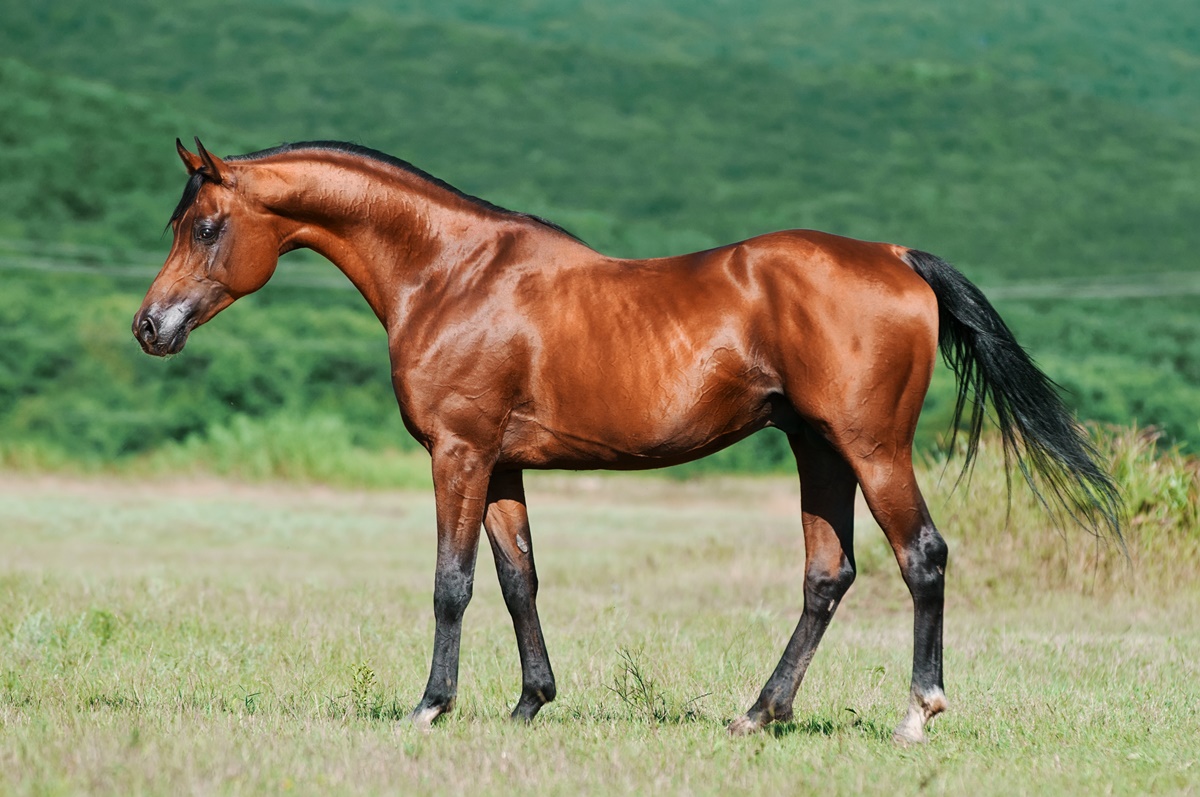
Wśród koni arabskich wyróżnia się kilka rodzajów - trzy najbardziej znane typy koni arabskich wywodzą się od wspomnianych wcześniej ogierów - ojców poszczególnych linii:
Kuhailan – należą do grupy koni hodowanych z przeznaczeniem jako koń bojowy lub użytkowy, silny, z mocną szyją i dużą głową, zazwyczaj bez szczupaczego, czyli wklęsłego profilu (z którym wielu kojarzy konie arabskie) – maść zazwyczaj gniada lub skarogniada,
Saklavi – drugi z typów konia arabskiego w którym koń jest nieco niższy i delikatniejszy niż Kuhailan, jednak niemniej wytrzymały, często przez laików przedstawiany jest jako wzorcowy w rasie, chętnie prezentowany i fotografowany - o szczupłej, lekkiej budowie, szczupaczym profilu głowy i wielkich nozdrzach - najczęściej siwy. Niegdyś hodowany na pokazy, spacery i jako koń dla dam.
Munighi – koń o długich kończynach, węższej i dłuższej głowie niż poprzednie typy - z prostym profilem, skośnymi łopatkami - zazwyczaj kasztanowatej maści - wytrzymały i szybki na krótkich dystansach, chętnie wybierany na tory wyścigowe,
Koń czystej krwi arabskiej słynie z galopu - wydajnego, szybkiego, a jednocześnie lekkiego. Rasa ta, może bez przeszkód poruszać się galopem, pokonując wielokilometrowe trasy. Kłus jest równie lekki z wydłużoną fazą lotu, szczególnie imponująco wygląda, gdy rasa ta jest czymś poruszona, rozemocjonowana - z rozwartymi dużymi chrapami i uniesionym w powietrzu ogonem wygląda zjawiskowo. Stęp koni krwi arabskiej bywa często zbyt krótki, ale mocno energetyczny jak i sama rasa.
Osiągany wzrost: 145-155 cm
Masa ciała: 400-450 kg
Maść: ich umaszczenie zawiera wszystkie podstawowe maści, poza umaszczeniem srokatym; często siwe z hreczką, jabłkowite i z odmianami na nogach oraz głowie; rzadko spotykane są osobniki kare.
Konie arabskie - użytkowanie
Niegdyś rasę tę używano głównie jako koni bojowych w związku ich cechami i predyspozycjami, które umożliwiały pokonywanie długich dystansów wśród pustynnych piasków oraz szybki atak. Dziś rasę tą spotkamy głównie podczas pokazów. Jest to koń dosyć skoczny, elastyczny, inteligentny oraz chętny do nauki. Rasa coraz częściej sprawdza się w tzw. małym sporcie, pojawiając się również w klasach western, skokach i ujeżdżeniu.
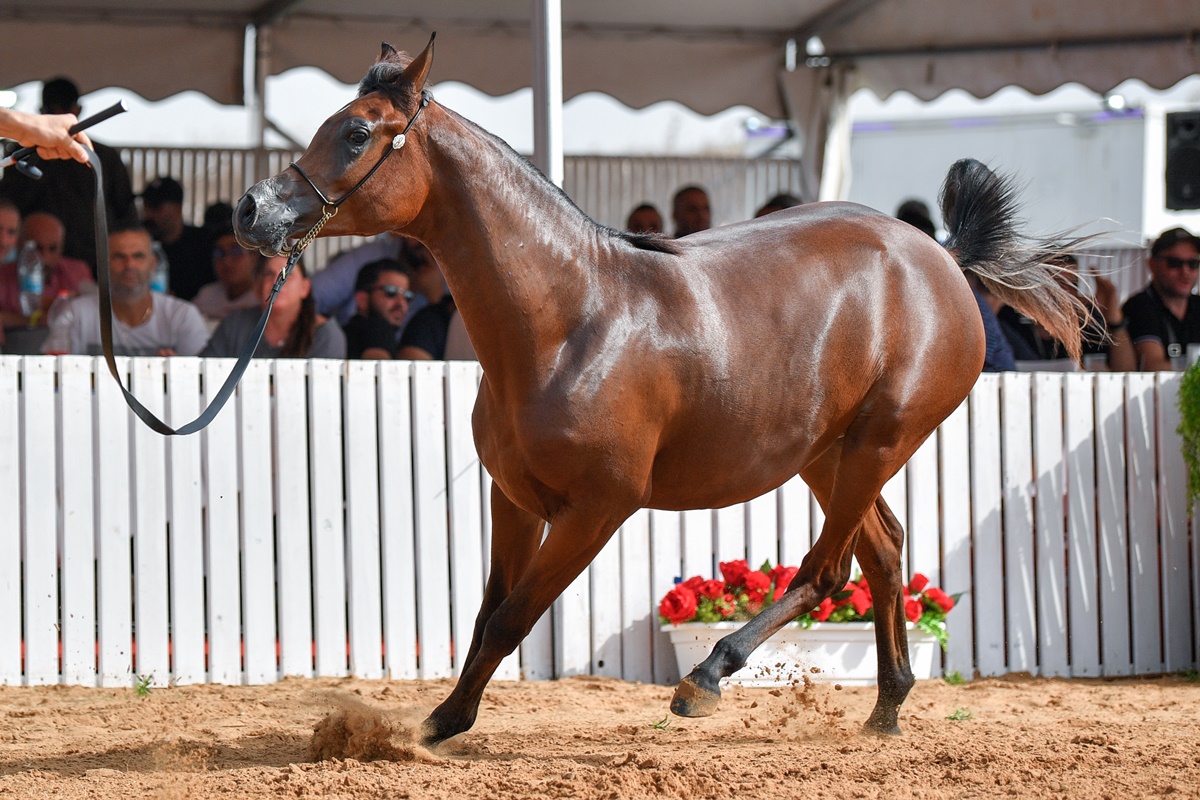
Koń arabski to również koń “energetyczny” - posiada żywy temperament, jest mocno wrażliwy na bodźce, niespokojny, łatwiej płoszący się przez co nie jest zalecany do jazdy rekreacyjnej czy też nauki jazdy w siodle, kiedy jeźdźcy nie mają jeszcze wystarczających umiejętności. Konie czystej krwi arabskiej uchodzą za niezwykle wytrzymałe a więc świetnie odnajdują się na krótszych i szybkich dystansach, ale również w dyscyplinie rajdów długodystansowych.
Szczególnie predestynowane są do sportowych rajdów konnych - świetnie wykorzystując swój wydajny galop. Konie arabskie mają sprzyjającą rajdom budowę - lekką i mocną konstytucję, oraz dobre, silne i zazwyczaj poprawnie zbudowane kończyny, co jest kluczowe na długich dystansach (do 160 km dziennie). W tej dyscyplinie szczególnie docenia się też ich upór, zdolność do szybkiej regeneracji oraz pokonywania trudnych tras na dystansach długich, często w wysokich temperaturach.
Ile żyje koń arabski?
Konie arabskie charakteryzuje długowieczność i płodność - dożywają ponad 30 lat. Dojrzałość płciową osiągają w wieku ok. 3,5 lat, a okresu wzrostu i rozwoju kończy się jak u większości koni - w wieku 5 lat.
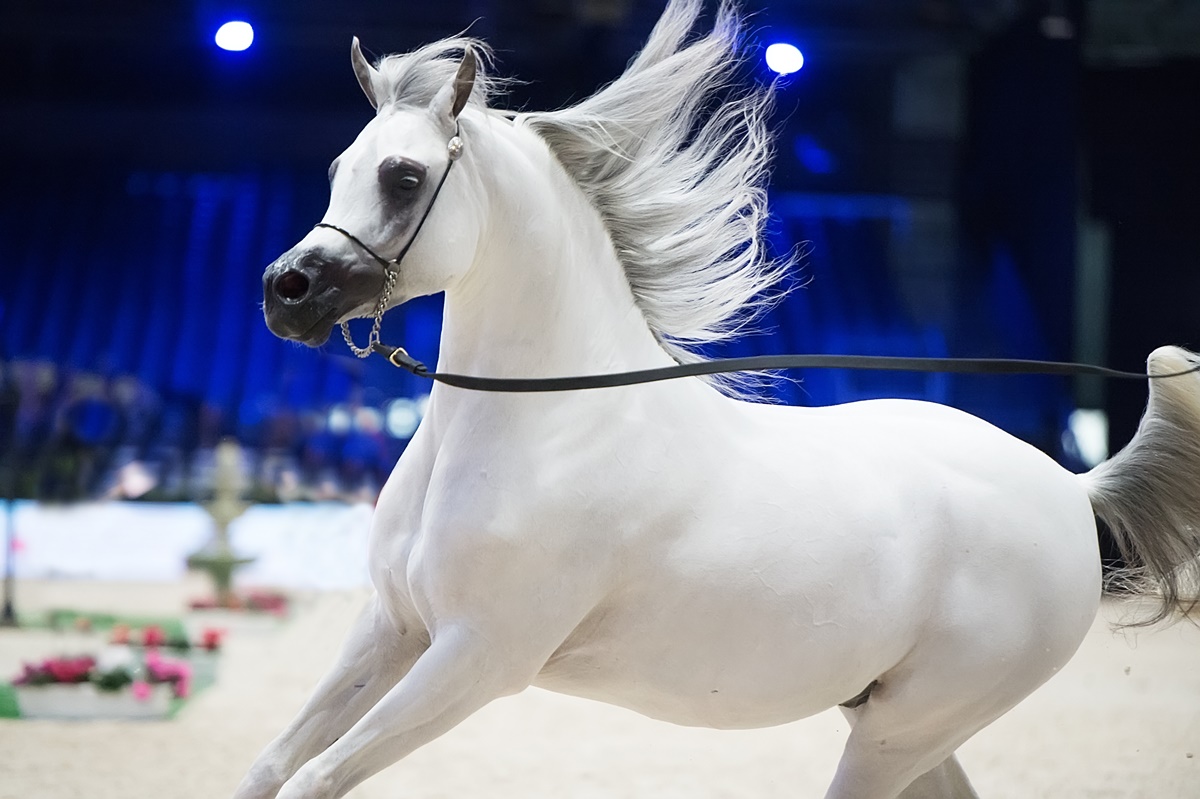
Ile kosztuje koń arabski?
Najdroższy, sprzedany koń arabski w Polsce kosztował 1,4 mln euro. Najtańsze kosztują ok. 10 tys. złotych. Ceny koni arabskich są zależne od wieku, pochodzenia, poziomu wyszkolenia koni.
Koń angloarabski a arabski
Konie angloarabskie (xxoo) - czyli angloaraby to połączenie dwóch ras - koni czystej krwi arabskiej (oo) oraz czystej krwi angielskiej (xx), czyli tzw. folblutów. Krzyżówka ta dała świetne konie sportowe, choć o “gorącej głowie” - co świetnie określa ich temperament. Są szybkie, smukłe i wytrzymałe. Mają płaskie, wydaje chody i są bardzo skoczne.
Ich hodowla rozpoczęła się dzięki wojnom oraz wymianom handlowym - w wyniku czego do Francji przybyły konie orientalne (araby). Francuski władca, Napoleon Bonaparte bardziej niż masywne konie cenił sobie lekkie wierzchowce Orientu. Z jego polecenia gromadzono sprowadzone z wojny ogiery arabskie w stadninie Pompadour.
Hodowlę opartą o angloaraby prowadził już książe Palatynatu Christian IV w Zweibrücken, gdzie wyhodował ojców-założycieli tej rasy. W oparciu o uzyskane konie Eugene Gayot - dyrektor stadniny w Pompadour (a od 1847 r. generalny inspektor wszystkich francuskich stadnin) oficjalnie rozpoczął hodowlę rasy koni angloarabskich we Francji na większą skalę.
Dziś koń angloarabski hodowany jest nadal głównie we Francji (stadniny Pau, Pompadour i Tarbes, ale również w Polsce (Pruchna, Walewice, Janów Podlaski) i Anglii.
- Maść: najczęściej gniada, kasztanowata lub siwa
- Wzrost: 155-165 cm
Inne pokrewne rasy to angloarab sardyński (hodowla na Sardynii, stado ogierów Chilivani, prywatna stadnina Scuderia de Nora) oraz angloarab Shagya (rasa powstała na terenie monarchii austro-węgierskiej, dziś hodowla głównie na terenie Węgrzech - Babolna, Słowacji - Topolczanka, Austrii oraz pozostałych krajów powstałych po rozpadzie monarchii i w Niemczech).
Podsumowanie
Koń czystej krwi arabskiej nawet na laiku robi niesamowite wrażenie. Pełne gracji, z lekkim, wydającym się płynąć ruchem. To jedna z najbardziej znanych i najstarszych ras koni na świecie. Jest ona ceniona nie tylko ze względu na swoje piękno, ale również niebagatelne ceny, które osiąga na światowych aukcjach.

















